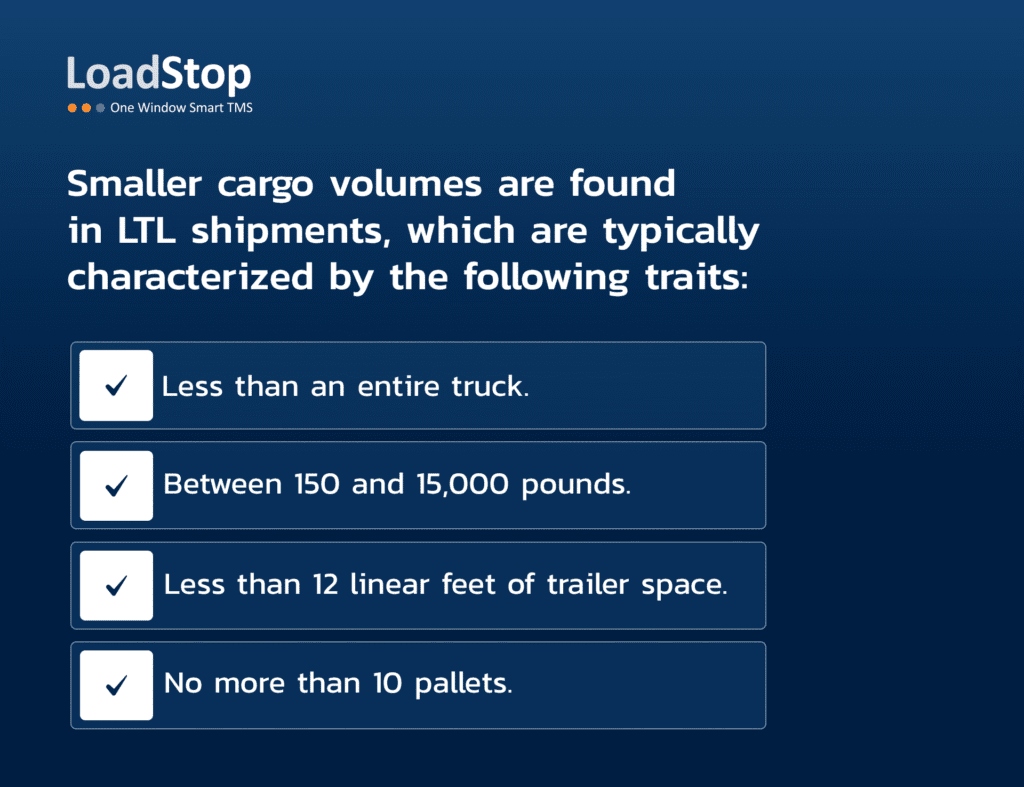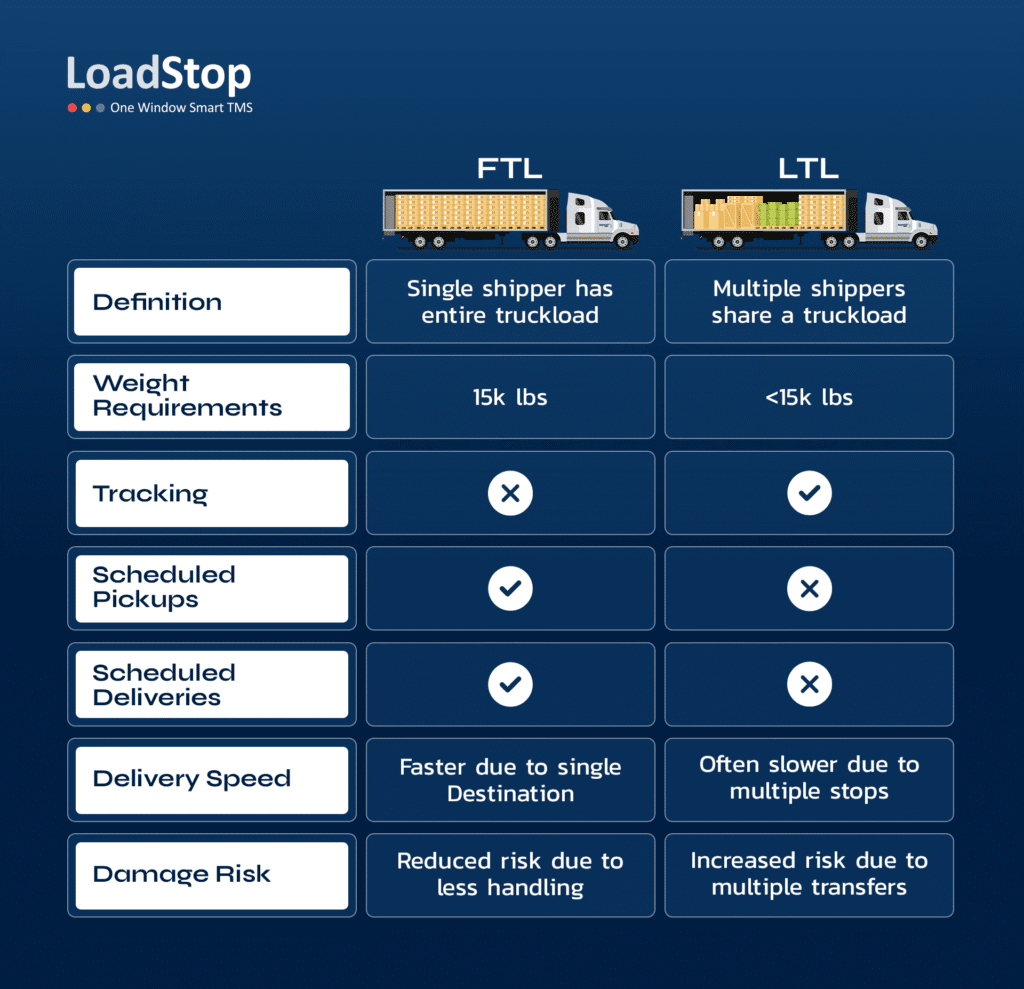Welcome to the crazy, incredibly complicated world of LTL trucking, where your logistics team either loves it or freaks out, your freight shares a trailer, and your budget breathes easier.
LTL shipping has rapidly evolved from a “niche option” to a “logistics necessity” for contemporary supply chains. Additionally, protecting sanity is more important than simply saving space. LTL has emerged as the preferred option for shippers seeking flexibility without the full-truckload cost due to the growth of e-commerce, decreasing order quantities, and just-in-time delivery requirements.
Let’s face it, though: LTL may sometimes feel like Tetris, just with invoices. It’s not quite a plug-and-play experience because of carrier cutoffs, varying rates, and unexpected accessories.
The worst part is that, according to the ATA Report, LTL generates over $88 billion annually, or almost 10% of all transportation income in the United States, despite moving less freight than full truckloads. For shippers who are clever, that means huge money, large stakes, and big prospects.
Let’s explore what drives the LTL industry and how you may take advantage of it.
What is LTL trucking
Transportation of items or supplies that don’t require a full truckload is referred to as less than truckload (LTL) freight. Many different cargoes are usually transported on a single truck as a result of these smaller freight loads. Pallets are typically used for LTL freight shipments, which can weigh anywhere from 150 to 10,000 pounds.
LTL carriers are experts at efficiently moving more cargo for more shippers by optimizing their loads. LTL freight shipping is preferred by shippers because of its cost-effectiveness, flexibility, and environmental friendliness. LTL trucking, though, may be rather complicated.
How does LTL freight work
In essence, LTL freight shipments produce whole multi-stop truckloads by combining partial loads. The type of things being sent, the amount of space needed, and the pickup and destination locations all affect the cost of shipping.
LTL freight might be guaranteed, expedited, or transported normally. Special services can also be added to LTL freight shipping. These services include residential pickup and delivery, interior pickup and delivery, and lift gate pickup and delivery. Accessorial fees are extra charges for these services.
In order to link shippers with accessible LTL capacity, freight brokers and carriers are essential. They provide shippers with options for various carriers, negotiate prices, and guarantee the prompt delivery of products.
Although LTL shipments do not have any special package standards, shippers must wrap their trucks properly to avoid damage during transit. To guarantee safe transportation, shippers must fasten their cargo to pallets and use strong packaging materials.
Key characteristics of LTL shipment
For freight that is too big for parcel services but too little to warrant a full truckload, less-than-truckload (LTL) shipping is the best option. For companies delivering lesser quantities, it’s an affordable and adaptable option, particularly when efficiency and speed are still important.

An LTL shipment is often defined as follows:
Smaller Cargo Volume: LTL shipments typically weigh between 150 and 15,000 pounds, making them perfect for small-to-mid-size loads that don’t require exclusive trailer space.
Partial Trailer Space: Less than 12 linear feet of trailer space is often required for an LTL shipment. Your freight shares the truck with shipments from other businesses, which helps reduce costs.
Pallet Count: LTL cargoes typically contain a maximum of ten pallets. In order to improve loading, unloading, and stacking efficiency, freight is typically palletized or crated.
Cost Sharing: It’s more economical than full truckload (FTL) shipping because you only pay for the space your freight takes up, so you share the cost with others.
Multiple Stop Routing: Hub-and-spoke networks or terminals are frequently used for LTL shipments. In contrast to FTL, your freight is picked up, sorted, and moved before arriving at its destination, which may result in a little longer travel time.
More Handling: LTL shipments are handled more frequently as a result of freight transfers between terminals and carriers, necessitating the usage of secure packaging to prevent damage.
Accessorial Services: Small businesses frequently ask for extra services like liftgate delivery, residential drop-offs, or inside delivery, which LTL shipping enables.
Is LTL freight a good option for companies
It combines flexibility, efficiency, and access to professional logistics services, making it a powerful option in today’s fast-paced, customer-driven market.
SMB friendly
LTL shipping and trucking is quite advantageous for small businesses. Compared to huge corporations, the majority of small firms ship fewer items and spend less on freight. Small businesses can take use of expert shipping services without having to pay exorbitant fees for extra space, thanks to LTL freight shipment.
For truckers
Scheduling with LTL freight clients allows you to meet the demands of several clients on a streamlined route, saving money on gasoline and other expenses.
Flexibility and accessibility
For enterprises, LTL freight provides an accessible and adaptable alternative. Without having to commit to entire truckloads, they can access a wide range of carriers and destinations.
Less carbon footprint
Instead of more trucks transporting less-than-load freight, the LTL freight delivery procedure results in fewer trucks transporting full loads. As fewer vehicles are required to transport items to their final destinations, emissions and the carbon footprint of your business are decreased.
Suitable for eCommerce
Businesses must make sure that their shipping strategies meet the expectations of their clients in a world where online shopping has become commonplace.
By avoiding the need for every shipment to fill a full truckload, LTL freight shipping increases productivity and delivery times. When you use LTL freight transportation, you can be sure that your inventory or freight will arrive at its destination on time.
How is LTL freight different from FTL freight
Of course, the cargo size is the primary distinction between full truckload (FTL) and LTL freight. FTL denotes a shipment that requires a full truckload, whereas LTL denotes a shipment that is less than a full truckload. The distinctions aren’t particularly clear, though.
As we previously covered, LTL truck shipments are characterized by specific weight and size requirements, usually a maximum of 10 pallets and 15,000 pounds. Generally speaking, anything beyond 15,000 or 10 pallets is regarded as FTL.

Common challenges of LTL freight
LTL freight has drawbacks even though it provides flexibility and financial savings. Businesses must carefully plan to minimize delays, additional expenses, or service gaps due to factors like lengthier travel times, limited carrier availability, and the requirement for exact shipment specifications.
Time constraint
With LTL freight, flexibility and cost may come at the expense of expediency. It frequently takes longer for freight to arrive because each vehicle is carrying shipments from several businesses traveling to several adjacent areas.
Make sure to allow extra time for LTL freight shipping compared to a typical truckload cargo.
Carrier capacity
Not all carriers provide LTL trucking/shipping, in contrast to full truckload shipping. It can be difficult to find a carrier willing to convey LTL freight at a reasonable cost.
To get beyond this obstacle, allow enough time to look for a carrier or utilize a free quote tool to find carriers that meet your expectations in terms of pricing and service.
Shipment detail
Paying attention to the details is necessary while shipping LTL freight. The price your company pays for LTL freight depends on a number of criteria, including freight class, weight, pickup and destination locations, deadline, etc.
To receive the best deal and level of service, carefully consider every detail while planning the logistics of your LTL freight shipments.
Best practices of LTL freight shipping
These best practices, which range from utilizing cutting-edge technology to collaborating with consolidators and offering precise shipment data, aid in streamlining processes, cutting expenses, and fostering closer ties with carriers.
Implement a TMS
Shipment optimization, visibility, business analytics, and global supply chain talent are all provided by a transportation management system (TMS). These systems give your global supply chain a competitive edge, increase efficiency, and save expenses.
Every LTL trucking load should be able to be analyzed by a TMS to see whether it can merge with other loads on adjacent routes. With this information, it then creates multi-stop full truckloads of freight.
The expertise provided by a TMS helps your organization choose an LTL carrier, receive the correct rates, properly optimize goods and routes, and answer any questions you may have along the way.
Leverage consolidators
Unless you have a substantial LTL volume, you cannot consolidate freight, regardless of how good your software is. Thankfully, freight consolidators make it possible for even tiny volumes to ship via LTL.
In order to construct full truckloads, LTL freight consolidation providers bring partial loads from numerous shippers to their consolidation centers. Savings and efficiency are achieved when LTL freight consolidators are used.
Individual LTL orders are combined from various shippers into one full truckload to provide shippers with reliable, on-time, in-full nationwide delivery for their partial shipments. Freight often comes into the consolidation center and goes out within 24 hours.
Despite the busy nature of these warehouses, freight is typically handled less often than a typical LTL load, cutting down on potential damage and claims.
Accurate information for shipment
Carriers have to invest more time, money, and resources in handling freight that has been recorded or packaged incorrectly.
By providing accurate information about your shipments (weight, freight class, etc.) and packing them appropriately according to the freight’s attributes, you can keep your relationships with carriers positive. This improves your relationship with your LTL carriers while saving them time and money.
LoadStop is your partner to optimize LTL freight
LoadStop is more than just another TMS when it comes to handling the intricacies of the LTL freight sector; it is the astute, scalable, and technologically advanced partner that brokers and carriers require in order to succeed.
It provides carriers with automatic pickup scheduling, dynamic route optimization, and sophisticated load planning tools. These characteristics make it simpler to profitably combine smaller shipments, decrease deadhead miles, and increase trailer use.
LoadStop offers brokers smooth document management (such as eBOLs and PODs), automatic carrier matching, and real-time rate visibility. You can compare rates instantly, book loads more quickly, and minimize accessory surprises with integrated LTL rating engines and API connectors.
Quotes, tracking, billing, and communications are all centralized, making it easier for your LTL operations to go from quote to final delivery. In an industry where inefficiencies cost money and time, LoadStop gives you the control and visibility you need to ship more efficiently.
Move smarter, quote faster, and optimize every load
Book a DemoFAQs
Usually, freight class, weight, distance, size, and extra ancillary services determine LTL rates. Your price will be more accurate if you include more specific shipment information.
Key factors include shipment size and weight, delivery zones, freight class, fuel surcharges, accessorial fees (like liftgate or residential delivery), and current market demand.
In contrast to conventional TMS solutions, LoadStop provides automatic carrier selection, real-time LTL pricing, and integrated visibility tools specifically designed for LTL operations. Without the bloat of old systems, its end-to-end automation, customized workflows, and modern user interface offer users greater control and quicker execution.



